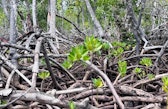Meet the researcher: Cecilia Olima, PhD candidate in the Integrative Biodiversity and Conservation Science
News
Publish date: November 14, 2025

Meet the researcher: Cecilia Olima, PhD candidate in the Integrative Biodiversity and Conservation Science
News
Publish date: November 14, 2025
Along Kenya’s coast, mangrove forests have long sustained both people and nature, and local knowledge guides how they are protected, used, and restored. These day-to-day choices are questions of the sustainable use of ecosystems, the focus of researcher Cecilia Olima. She investigates how such locally informed governance affects the value of mangrove ecosystem services over time—and what that means for livelihoods and ecosystem conditions.
What does “sustainable use of ecosystems” mean in this context? Cecilia explains it through the lens of ecosystem services: “Sustainable use of ecosystem services means utilizing the benefits that nature provides in a way that preserves the ecosystem's capacity to continue functioning and supporting human well-being over time.” In Lamu, this includes best fishing practices, controlled wood harvesting, and restoration efforts. These practices help people meet daily needs while keeping the ecosystem healthy.


Cecilia is a PhD candidate in the Integrative Biodiversity and Conservation Science Research Team at the Wyss Academy for Nature. In Lamu, she focuses on mapping and valuing the ecosystem services of mangrove forests under current conditions and in plausible alternative scenarios. Her research uses a stakeholder-based approach—one that starts in dialogue and pairs local knowledge with data-driven analysis.
“For me, this looks like spending time with communities in Lamu to understand how they experience and value mangrove ecosystems, not only through workshops, but also through everyday conversations, participatory scenario development and field visits. This means involving fisherfolk, women, youth, elders, and local officials, and research institutes—not just as informants, but as co-researchers, storytellers, and decision-makers. Whether planning restoration work or exploring livelihood alternatives, their voices guide what to prioritize and which solutions are viable in the long term.”
Building on this approach, one of Cecilia’s recent contributions was to lead scenario development and valuation for mangrove ecosystems in Lamu. “I co-facilitated workshops using the Kesho tool, integrated stakeholder narratives with spatial modelling, and assessed future changes in ecosystem service values under different governance assumptions,” she says. The work turns locally defined questions into analysis and decisions. It provides grounded evidence for decisions in Lamu and offers insights that can be adapted in other contexts.
“During our participatory scenario workshop in Lamu, we invited local voices to reflect on the past, present, and future of the mangrove forests. Using the Kesho tool, participants identified key drivers of change and collaboratively developed future scenario narratives,” Cecilia recalls. “These narratives revealed that when local knowledge and sustainable practices are prioritized, the outcome is healthier ecosystems, more stable livelihoods, and greater community resilience.”
Among the futures developed, two storylines captured the stakes. One of those narratives described a hopeful future, “where investing in community-driven land management led to thriving mangrove ecosystems and improved well-being for the people who depend on them.” “On the other hand,” she reflects, “without a meaningful action, communities may instead face a growth trap—a future defined by rapid degradation and the loss of critical natural resources.”

While our core work in Kenya centers on northern rangelands, the Lamu work applies the same system transformation approach in a coastal context. We link science, policy, and practice—co-defining questions with local actors, testing options through participatory scenarios and spatial analysis, and feeding results into governance and livelihood choices.
Within this context, Cecilia’s work remains anchored in equity and inclusion: “I hope my work contributes to more just and resilient coastal landscapes,” she says, “where communities are empowered to shape the future of natural ecosystems through inclusive governance, sustainable practices, and recognition of local knowledge.” In the end, the aim is straightforward: to keep the roots between people and place strong—across seasons and generations.